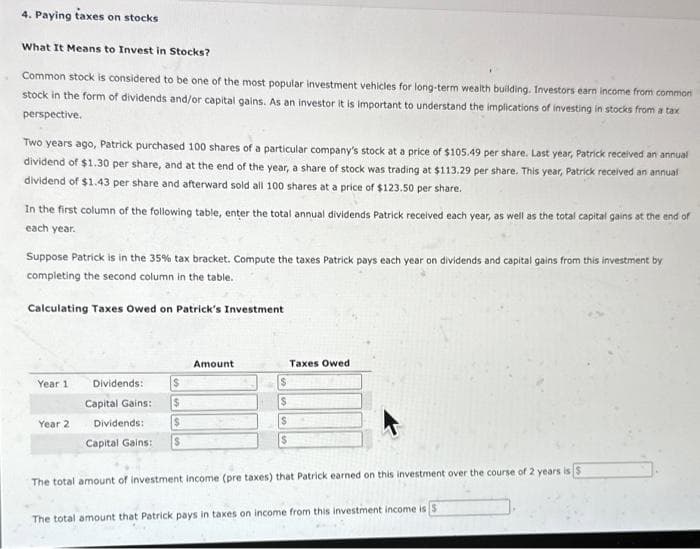4. Paying taxes on stocks What It Means to Invest in Stocks? Common stock is considered to be one of the most popular investment vehicles for long-term wealth building. Investors earn income from common stock in the form of dividends and/or capital gains. As an investor it is important to understand the implications of investing in stocks from a tax perspective. Two years ago, Patrick purchased 100 shares of a particular company's stock at a price of $105.49 per share. Last year, Patrick received an annual dividend of $1.30 per share, and at the end of the year, a share of stock was trading at $113.29 per share. This year, Patrick received an annual dividend of $1.43 per share and afterward sold all 100 shares at a price of $123.50 per share. In the first column of the following table, enter the total annual dividends Patrick received each year, as well as the total capital gains at the end of each year. Suppose Patrick is in the 35% tax bracket. Compute the taxes Patrick pays each year on dividends and capital gains from this investment by completing the second column in the table. Calculating Taxes Owed on Patrick's Investment Year 1 Year 2 Dividends: $ Capital Gains: $ $ Capital Gains: S Dividends: Amount $ $ Taxes Owed The total amount of investment income (pre taxes) that Patrick earned on this investment over the course of 2 years is 5 The total amount that Patrick pays in taxes on income from this investment income is S
4. Paying taxes on stocks What It Means to Invest in Stocks? Common stock is considered to be one of the most popular investment vehicles for long-term wealth building. Investors earn income from common stock in the form of dividends and/or capital gains. As an investor it is important to understand the implications of investing in stocks from a tax perspective. Two years ago, Patrick purchased 100 shares of a particular company's stock at a price of $105.49 per share. Last year, Patrick received an annual dividend of $1.30 per share, and at the end of the year, a share of stock was trading at $113.29 per share. This year, Patrick received an annual dividend of $1.43 per share and afterward sold all 100 shares at a price of $123.50 per share. In the first column of the following table, enter the total annual dividends Patrick received each year, as well as the total capital gains at the end of each year. Suppose Patrick is in the 35% tax bracket. Compute the taxes Patrick pays each year on dividends and capital gains from this investment by completing the second column in the table. Calculating Taxes Owed on Patrick's Investment Year 1 Year 2 Dividends: $ Capital Gains: $ $ Capital Gains: S Dividends: Amount $ $ Taxes Owed The total amount of investment income (pre taxes) that Patrick earned on this investment over the course of 2 years is 5 The total amount that Patrick pays in taxes on income from this investment income is S
Intermediate Financial Management (MindTap Course List)
13th Edition
ISBN:9781337395083
Author:Eugene F. Brigham, Phillip R. Daves
Publisher:Eugene F. Brigham, Phillip R. Daves
Chapter15: Distributions To Shareholders: Dividends And Repurchases
Section: Chapter Questions
Problem 5Q: Indicate whether the following statements are true or false. If the statement is false, explain why....
Related questions
Question
hd.26.

Transcribed Image Text:4. Paying taxes on stocks
What It Means to Invest in Stocks?
Common stock is considered to be one of the most popular investment vehicles for long-term wealth building. Investors earn income from common
stock in the form of dividends and/or capital gains. As an investor it is important to understand the implications of investing in stocks from a tax
perspective.
Two years ago, Patrick purchased 100 shares of a particular company's stock at a price of $105.49 per share. Last year, Patrick received an annual
dividend of $1.30 per share, and at the end of the year, a share of stock was trading at $113.29 per share. This year, Patrick received an annual
dividend of $1.43 per share and afterward sold all 100 shares at a price of $123.50 per share.
In the first column of the following table, enter the total annual dividends Patrick received each year, as well as the total capital gains at the end of
each year.
Suppose Patrick is in the 35% tax bracket. Compute the taxes Patrick pays each year on dividends and capital gains from this investment by
completing the second column in the table.
Calculating Taxes Owed on Patrick's Investment
Year 1
Year 2
Dividends: $
Capital Gains:
Dividends:
Capital Gains: $
Amount
$
$
$
Taxes Owed
The total amount of investment income (pre taxes) that Patrick earned on this investment over the course of 2 years is 5
The total amount that Patrick pays in taxes on income from this investment income is S
Expert Solution
This question has been solved!
Explore an expertly crafted, step-by-step solution for a thorough understanding of key concepts.
This is a popular solution!
Trending now
This is a popular solution!
Step by step
Solved in 3 steps

Recommended textbooks for you

Intermediate Financial Management (MindTap Course…
Finance
ISBN:
9781337395083
Author:
Eugene F. Brigham, Phillip R. Daves
Publisher:
Cengage Learning

EBK CONTEMPORARY FINANCIAL MANAGEMENT
Finance
ISBN:
9781337514835
Author:
MOYER
Publisher:
CENGAGE LEARNING - CONSIGNMENT


Intermediate Financial Management (MindTap Course…
Finance
ISBN:
9781337395083
Author:
Eugene F. Brigham, Phillip R. Daves
Publisher:
Cengage Learning

EBK CONTEMPORARY FINANCIAL MANAGEMENT
Finance
ISBN:
9781337514835
Author:
MOYER
Publisher:
CENGAGE LEARNING - CONSIGNMENT
